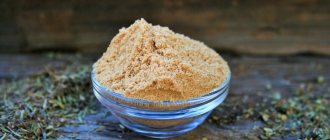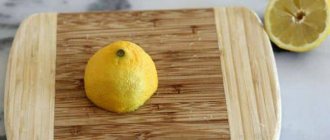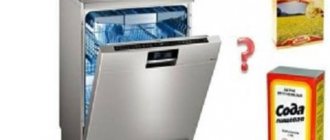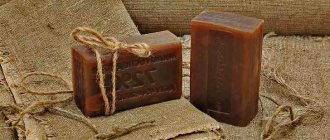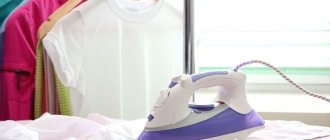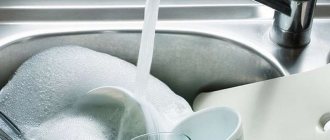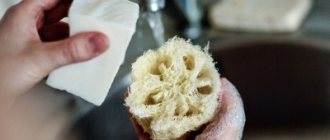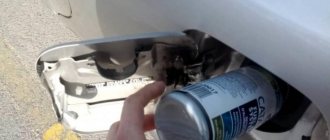In this topic we will look at recipes for homemade dishwashing detergents.
Today, homemade dishwashing liquid is extremely popular. Undoubtedly, household chemicals perform their functions quickly and efficiently, without leaving streaks or residue. And in stores you can see a riot of different bottles for every taste. But few people study the composition of these products and their effect on the human body. Therefore, we want to offer a harmless dish gel that you can make yourself.
Use of disinfectants
Most existing detergents today are produced exclusively in concentrate form. Subsequently, special working solutions of various disinfectants are created from them. They simply add water in a certain amount. After this, the resulting solution is used to treat various surfaces and absolutely all objects with which only a person can interact on a daily basis. Most tools, linens, utensils in the kitchen and food service areas use the immersion method. But if there is a need to treat a surface with a large area, then disinfection is carried out by irrigation or wiping.
How can I independently determine the concentration of the product that will be needed for processing? First of all, it is necessary to understand which object will be subject to disinfection, which of the existing modes will be chosen.
Main Ingredients
Dishwashing detergent has several tasks: to dissolve fats, clean plaque and carbon deposits, and disinfect. In addition, you need to take care to protect the skin of your hands and have a pleasant smell.
Dirty dishes require a comprehensive approach to constant washing and regular cleaning
So, let's figure out what you need to prepare an effective and safe dishwashing detergent that will cope with all your tasks.
Fat solvents
First of all, it should be said that fats dissolve better and are washed off from dishes with hot water . Therefore, if it is not there, you will have to heat it on the stove to 40-45 ℃. Dishes made from high-quality materials that can withstand high temperatures can simply be doused with boiling water and then rinsed under running water, wiping the surface with a sponge without any additional means.
Under hot water, grease from plates can be easily washed off with a sponge.
Mustard powder is an affordable natural remedy that breaks down fats well. The only negative is that it does not cope well with complex contaminants in cold water. Mustard is used both in pure (dry powdered) form and in custard form; mixed with other components that enhance its effectiveness and allow you to make a more effective liquid dishwashing detergent with your own hands.
Laundry soap . Its universal properties are widely used in everyday life, from removing stains of various origins to washing hair. This type of soap is considered environmentally friendly and hypoallergenic, since it does not contain synthetic substances, dyes or flavors.
There are only two components in laundry soap - sodium or potassium salt and fatty acids.
Instead of laundry soap, you can use baby soap, bleach soap, or any toilet soap.
Abrasive powders
Many ready-made pastes and gels for dishes contain small particles of spar, silica, pumice, sand and other insoluble minerals. The presence of solid powder abrasives with varying degrees of grinding allows you to mechanically scrub off dense contaminants - plaque, soot, scale.
The larger the abrasive particles in the cleaning product, the greater the likelihood of damaging the surface being scrubbed.
The easiest way to ensure that your homemade dishwashing detergent cleans well and does not scratch the surface too much is to use soda (baking or soda ash). Also, environmentally friendly abrasives can be mustard powder, grounds from brewed ground coffee, crushed chalk or crushed eggshells.
Disinfectant additives
Leftover food serves as an excellent breeding ground for bacteria, so when washing dishes it is important to take into account such an aspect as disinfection.
If you want to make a disinfectant dishwashing detergent with your own hands, then use alcohol-containing liquids (vodka, ethyl alcohol or ammonia) and hydrogen peroxide as antiseptic and antibacterial additives.
Alcohols, especially ammonia, should be added in small quantities, given their pungent and often unpleasant odors.
Softeners and flavors
The products listed above will help you wash dirty dishes efficiently, but many of them dry out the skin of your hands and smell bad.
Natural essential oils simultaneously soften and scent homemade cleaning products
A good softening effect is achieved by adding liquid glycerin . And in order to make dishwashing detergent and ensure that it is gentle not only on your hands, but also on your sense of smell, the simplest and most accessible means are all kinds of essential oils . The main thing is to take natural ones that you like by smell and in small quantities.
Consider the possibility of allergic reactions to certain types of oils. To reliably protect the skin of your hands, make it a rule to wash dishes with gloves.
Now we offer you several standard home recipes on how to make dishwashing detergent with your own hands. They can be followed exactly or considered as basic, making your own changes and additions.
Types of disinfection modes
- In case of viral diseases;
- For fungal diseases;
- For tuberculosis;
- For any bacterial infections, with the exception of tuberculosis.
To determine the regime, first of all, it is worth starting from the epidemiological danger of a particular object. In public places, such as educational schools, in most cases, disinfection is carried out exclusively in accordance with the bacterial regime. If it is necessary to disinfect instruments in a hospital or beauty salon, then the mode used for viral diseases is selected.
In reality, sterilization differs only in the concentration of a particular solution and exposure time. Thus, when processing any items according to the most common regime for viral diseases, the most concentrated solution is used, as well as a greater exposure in comparison with the processing that is performed by specialists for bacterial diseases. The detailed instructions for any disinfectant always contain a table with a detailed indication of what concentration of the working solution should be used, as well as what exposure is needed in any of the modes when processing various objects.
Mustard powder dish detergent
Mustard powder removes fat well.
The simplest and most budget-friendly dishwashing detergent recipe is to use regular mustard powder. A package of this powder, weighing four hundred grams, will cost about one hundred rubles in a grocery store.
Recipe No. 1
To make your own dishwashing detergent you will need:
- hot water;
- damp sponge;
- mustard powder (1 teaspoon).
If you need to rinse a small amount of dishes, say one cup, it will be enough to simply sprinkle a pinch of mustard powder on a damp sponge and wash the dishes.
If you plan to thoroughly wash a large number of items, then you should take a basin, fill it with hot water, add a spoonful of powder into it and stir the resulting mixture until foam appears.
Soak a sponge in this solution and clean the dishes until they squeak, which will signal that the item is one hundred percent clean. For those who want to make an enhanced, already perfectly working product, it is also possible to add a teaspoon of soda to the solution. The remaining solution can be poured into the garden beds in a private house, and used in an apartment for watering and feeding flowers and house plants. The mustard solution will not harm the plants in any way.
Mix soda and mustard powder 1:1 and pour into a plastic container. The result is dry dishwashing powder.
Recipe No. 2
Components:
- hot water – 100 ml;
- soda – 1 tbsp. l.;
- mustard powder – 1 tsp.
Cooking method:
Add all ingredients to a container convenient for use when washing dishes and mix thoroughly until foamy.
Preparation of solutions of disinfectant detergents
Once the required concentration for the product solution has been determined, its preparation can begin. Actions must be carried out with personal protection. The minimum set is gloves, respirators and goggles. Creation and storage should be carried out in a room that will be designated for this and will not be accessible to other people.
You need to find special dishes made of plastic and glass. Pour the required amount of drinking water into it. She should be cold. To prepare the product according to the instructions, add concentrated disinfectant. Measure the volume using a glass / special measuring cap. The prepared aqueous solution is closed with a lid, a piece of paper is pasted indicating the name, concentration of the solution, instructions for the disinfectant, and the date of preparation. Having found a table on the Internet, it is very easy to calculate the proportions yourself, which can then be used to create any volume of working medium.
DIY liquid soap recipes
Products based on laundry soap
To prepare dishwashing detergent from laundry soap, it is recommended to take:
1. Ingredients : laundry soap shavings (1 tbsp), glycerin (4 tbsp), water (500 ml), vodka (1 tbsp).
Cooking technology . Rub the soap on a fine grater and pour in half a glass of hot water. Place the container with the soaked soap in a water bath (or in the microwave), stir and gradually add the remaining water until the soap is completely dissolved. Then let the homogeneous soap solution cool slightly and add glycerin and vodka. While the mixture is warm, it remains liquid; immediately pour it into a suitable bottle with a dispenser. When completely cooled, the product will thicken and acquire a gel consistency.
2. Ingredients : laundry soap (50 g - a quarter of a bar), water (1.5-2 l), soda ash (2 tbsp.) or baking soda (4-5 tbsp.), essential oil (10 drops ).
Cooking technology . Rub the soap and dissolve it in water, as in the previous recipe. Add soda to the hot soap solution and stir (the soda should completely dissolve). Wait for the mixture to cool, add essential oil. Mix. It is more convenient to keep the finished thick gel in a container with a dispenser, since before use you need to shake it well and shake it to squeeze it onto the sponge.
3. Ingredients : laundry soap (50 g), baking soda (3 tbsp), ammonia (2-4 tbsp), dry mustard powder (3 tbsp), water (1 l).
Cooking technology . Dissolve the grated soap by adding hot water and stirring constantly. Add mustard and soda to the cooled soap solution, stir well, pour in ammonia, stir. The resulting cleaning product should be allowed to sit for several hours in a container with the lid closed. When ready, its consistency should be pasty. It is convenient to store this product in a jar or container of a suitable size with a lid.
Mustard remedy
To remove dirt from dishes, many people use mustard powder in its original dry form.
Dry mustard powder is obtained by grinding grains
When using dry powder, the main thing is not to dip a wet rag into a container of mustard, but pour it onto a sponge or directly onto the surface of dirty dishes.
To prepare liquid dish detergent with your own hands based on mustard, you need to stir 2-3 tsp. powder in 1 liter of hot water, whisking until thick foam forms. The resulting solution should be used immediately; for convenience, pour it into a suitable dispenser or sprayer.
Safety precautions
The head of any institution must understand that the schedule for processing premises is his responsibility, as well as the health of each employee. Every employee involved in the use of disinfectants always undergoes safety training.
“The highest officials of each of the constituent entities of the country are obliged, together with companies, to take the necessary measures to ensure a disinfection regime,” notes epidemiologist and hygienist A.Yu. Popova.
In accordance with the sanitary standards in force in the country, citizens under 18 years of age and persons with allergic diseases cannot be allowed to work with disinfectants of any kind. Employees whose direct responsibilities include using disinfectants according to schedule must have a health certificate. The state obliges them to undergo special medical examinations.
When working with disinfectants, you should always use protective equipment. They are provided by the head of the company. It is important to avoid getting the disinfectant on an open area of the body. This can lead to consequences. You cannot eat or drink while working with disinfectants. Or it will become a violation. After completing work, the employee must wash their hands thoroughly with soap.
If the disinfectant gets into your eyes or skin, you should immediately rinse the area of contact with running water. It is the employer's responsibility to ensure that there is a first aid kit available to each employee.
In the context of the active spread of coronavirus, during the cold season, measures aimed at combating the epidemic should under no circumstances be neglected. It is important to perform high-quality, regular sanitization of all work surfaces, including all objects with which you interact daily.
Is it possible to wash dishes with laundry soap?
It is allowed to use laundry soap to wash dishes. It contains only natural ingredients - vegetable oils, fatty acids, sodium salts. At the same time, there are no harmful phosphates and surfactants in it. Laundry soap effectively breaks down fats due to its high alkali content and has a bactericidal effect.
Moreover, for dishes it is preferable to use a classic brown bar 72%; white may contain dyes, fragrances and preservatives. It is also undesirable to use liquid soap called “Laundry” for washing dishes and pots; it is better to prepare the product yourself.
Attention! Laundry soap dries the skin of your hands very much, so you need to use them only with gloves.
Coffee scented dishwashing liquid
Components:
- hot water – 250 ml;
- hard unscented soap – 150 g;
- borax in glycerin – 20 ml;
- citric acid - half a tsp;
- soda – 100 g;
- mustard powder – 50 g;
- ground coffee – 50 g.
Method of preparation: Take the soap and grind it using a blender, mixer or grater. Fill the mixture with heated water. Mix and foam with a fork or whisk. Add citric acid along with borax in glycerin. Let it sit for 2-3 hours. Add all other ingredients and mix thoroughly until it forms a paste.
How to prepare a soap-soda solution for disinfecting premises
Nowadays, stores offer a huge selection of detergents and disinfectants.
Many of them contain chlorine, which negatively affects health. It is possible to treat rooms with chlorine only in the absence of people. But even after such treatment, chlorine vapor remains in the air and enters the respiratory tract.
This is especially dangerous for children and people with allergies.
Soap and soda solution for disinfection is safe for health. It is recommended to be used for cleaning premises in children's institutions, hospitals and kindergartens. Toys and other common items are treated with soap and soda solution. This is especially important during epidemic periods.
At home, you can also wash floors, toys, and furniture with a soap-soda solution, especially if one of the family members is sick with a viral infectious disease.
An important quality of a homemade soap-soda solution is its low price. This is perhaps the cheapest disinfectant available in every home.
Depending on the degree of contamination of the room, prepare a one- or two-percent soap-soda solution.
To prepare a one percent soap-soda solution you will need:
- 10 liters of water;
- 100 g laundry soap;
- 100 g soda.
To prepare a two percent solution of soap and soda, take twice as much for the same amount of water. Instead of regular soda, you can use soda ash to wash floors. Premises in kindergartens are cleaned at least once a day. Treatment of floors at home should be carried out after contact with a sick person or once a day during epidemics.
Advantages and disadvantages of homemade cleanses
No matter what miracles with dishes are promised by intrusive advertising, some housewives prefer to mix dishwashing liquid themselves at home. A mixture prepared independently is more trustworthy due to the naturalness of the composition. But is it possible to wash dishes until they shine without using chemicals? The pros and cons of homemade products are presented in the table.
Table - Features of natural dishwashing detergents
| Advantages | Flaws |
| — Health safety; — quick rinsing with hot water from dishes and from the sewer; — the ability to control the composition by adding or removing the necessary components; - absence of fragrances and volatile synthetic substances that cause allergies and asthma; - low cost | — High mixture consumption; - less effective than chemical products (long washing process); - waste of time on preparation; - unpleasant odor of some mixtures |
Unlike ready-made detergents, homemade mixtures do not contain synthetic surfactants (surfactants), fragrances, or salts. To prepare homemade gels and solutions, natural soap is often used, which contains surfactants of plant or animal origin. Such substances decompose quickly and do not harm health.
How to treat children's toys with soap and soda solution
The following soap and soda solution is recommended for treating children's toys:
- 50 g soap;
- 2 tbsp. spoons of baking soda;
- 1 liter of warm water.
After treatment, the toys are rinsed in a weak solution of baking soda and wiped dry. Shared toys are washed every day. It is recommended to treat toys at home with soap and soda solution during epidemics and after contact with sick people.

